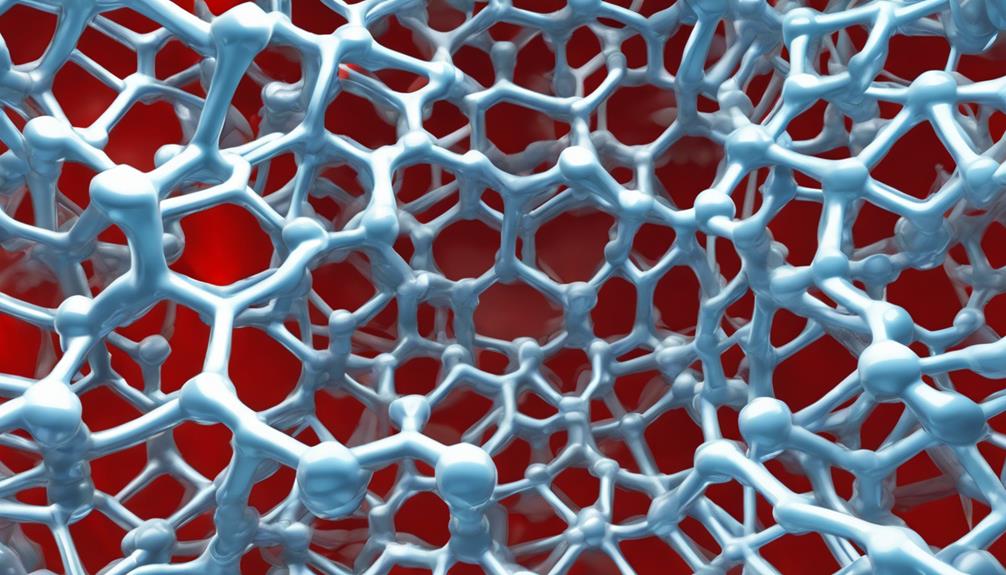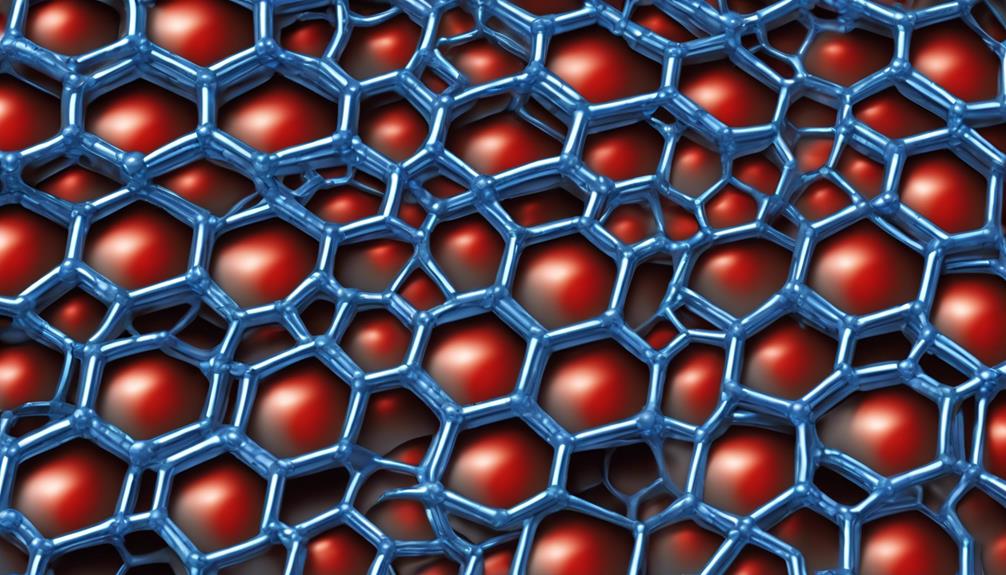As we explore the world of Al2O3, we're struck by the immense lattice energy of around 12000 kJ/mol that governs its behavior. But what makes this compound so stable and robust? We've found that factors like ionic bonding, crystal structure, and external influences all play a vital role in shaping its properties. From the strong electrostatic attraction between Al3+ and O2- ions to the impact of temperature and pressure, every aspect contributes to its remarkable lattice energy. As we dig deeper, we're about to uncover the intricate mechanisms that make Al2O3 a powerhouse in various applications – and we're just getting started.
Key Takeaways
- Al2O3's high lattice energy is due to the strong electrostatic attraction between Al3+ and O2- ions, resulting in high melting point and stability.
- The crystal structure of closely packed aluminum and oxygen ions in Al2O3 leads to strong electrostatic interactions, contributing to its high lattice energy.
- Temperature and pressure significantly influence Al2O3's lattice energy, with high temperature weakening ionic bonds and high pressure increasing lattice energy.
- Understanding Al2O3's lattice energy is crucial for predicting its solubility, melting point, and other properties, as well as its stability and reactivity.
- Accurate calculation of Al2O3's lattice energy using methods like Born-Haber cycles and computational modeling is essential for designing compounds with tailored properties.
Factors Influencing Lattice Energy

As we explore the intricacies of Al2O3 lattice energy, it becomes apparent that a complex interplay of factors influences its value, including the difference in charges of aluminum and oxygen ions, crystal defects, disruption of regular ion arrangement, and introduction of lattice vibrations.
The size and charge of ions also play a pivotal role, with the small size and high charge density of Al3+ and O2- ions contributing to a strong lattice energy. The charge density ratio is particularly significant, as it determines the strength of the electrostatic attraction between ions.
Additionally, the crystal structure of closely packed aluminum and oxygen ions, as well as the Born Haber cycle, are essential in calculating the lattice energy of Al2O3.
Ionic Bonding and Lattice Energy

Here is the output:
We explore the domain of ionic bonding, where the complete transfer of electrons between aluminum and oxygen atoms forms charged ions, culminating in a strong attraction that greatly contributes to the high lattice energy of Al2O3. This type of bonding is distinct from covalent bonds, where electrons are shared between atoms. The electrostatic attraction between the positively charged aluminum ions (Al3+) and negatively charged oxygen ions (O2-) is incredibly strong, resulting in a high lattice energy.
| Bond Type | Electron Transfer | Lattice Energy |
|---|---|---|
| Ionic | Complete | High |
| Covalent | Shared | Low |
| Metallic | None | Very Low |
| Hydrogen | Partial | Medium |
In Al2O3, the ionic bonding between aluminum and oxygen ions leads to a strong electrostatic attraction, which is responsible for the high lattice energy of this compound. This is evident in its high melting point and stability.
Crystal Structure Impact on Energy

We'll now explore how the crystal structure of Al2O3, characterized by closely packed aluminum and oxygen ions, greatly influences its lattice energy. The strong electrostatic interactions between these ions lead to a highly stable crystal lattice, resulting in a high melting point.
Crystal defects, such as vacancies or interstitials, can disrupt the regular ion arrangement, increasing the lattice energy. Understanding the crystal structure of Al2O3 is essential for grasping its stability and properties.
We'll investigate how the arrangement of atoms in the crystal lattice affects the lattice energy, and how changes in this arrangement can impact the overall energy of the compound.
External Factors and Energy Effects

Temperature and pressure are two external factors that significantly influence the lattice energy of Al2O3. Changes in these conditions impact the strength of ionic bonds and the arrangement of atoms in the crystal lattice.
When we increase the temperature, the thermal energy weakens the ionic bonds, leading to a decrease in lattice energy. On the other hand, high-pressure conditions decrease interionic distances, strengthening the bonds and increasing lattice energy.
We've found that pressure compression can even lead to higher lattice energy for Al2O3. Understanding how these external factors affect lattice energy is essential for predicting the properties and behavior of Al2O3 in various environments.
Experimental Determination of Energy

To accurately determine the lattice energy of Al2O3, we employ experimental methods like Born-Haber cycles and Hess's law, which provide a quantitative measure of the energy released during the formation of ionic bonds.
These methods allow us to calculate the lattice energy with high precision, giving us a deeper understanding of the ionic bonding in Al2O3.
Additionally, calorimetry and computational modeling are used to measure lattice energy accurately. By combining these approaches, we can obtain a thorough picture of the lattice energy of Al2O3, which is essential for predicting its solubility and stability.
Our experimental determination of lattice energy provides valuable insights into the stability and bonding of ionic compounds, guiding us in designing new materials with specific properties.
Lattice Energy and Compound Stability

The lattice energy of Al2O3 plays a pivotal role in determining the stability of the compound. It directly influences the strength of the ionic bonds holding the crystal lattice together.
We've seen how the high lattice energy of Al2O3 is attributed to the strong electrostatic attraction between the Al3+ and O2- ions. This strong attraction leads to a stable crystal lattice, which in turn affects the compound's solubility, melting point, and other physical properties.
Understanding the lattice energy of Al2O3 is essential in predicting its stability and behavior under various conditions. By analyzing the lattice energy, we can gain valuable insights into the compound's properties and potential applications.
Applications of Lattice Energy Knowledge

We can now utilize our comprehension of Al2O3's lattice energy to foresee the solubility and stability of ionic compounds, enabling the creation of new materials with specific properties.
By analyzing the lattice energy of various compounds, we can identify trends and patterns that inform our development of innovative materials.
For example, we can use lattice energy data to predict the reactivity of different ionic compounds, allowing us to create materials with tailored properties.
Moreover, our knowledge of lattice energy guides us in designing compounds with improved solubility, thermal stability, and mechanical strength.
Frequently Asked Questions
How Does the Lattice Energy of Al2o3 Compare to Other Ceramic Materials?
"We're curious about how Al2O3's lattice energy stacks up against other ceramic materials. Compared to most, Al2O3's lattice energy is remarkably high, thanks to its strong ionic bonds and compact crystal structure, making it a standout among ceramics."
Can the Lattice Energy of Al2o3 Be Altered Through Doping or Alloying?
"We can alter Al2O3's lattice energy through doping or alloying, introducing defects or modifying the crystal structure, which can lead to changes in the material's properties and stability."
What Is the Relationship Between Al2o3 Lattice Energy and Its Optical Properties?
We're exploring how Al2O3's lattice energy influences its optical properties, and we've found that changes in lattice energy can alter the material's refractive index, transparency, and absorption spectra, making it suitable for specific optical applications.
How Does the Lattice Energy of Al2o3 Affect Its Corrosion Resistance?
"Hold the phone, folks Along with its impressive optical properties, Al2O3's high lattice energy also boosts its corrosion resistance. We're talking strong ionic bonds, which make it super tough for corrosive agents to penetrate the crystal lattice."
Can the Lattice Energy of Al2o3 Be Used to Predict Its Mechanical Strength?
We explore if Al2O3's lattice energy can predict its mechanical strength, considering how strong ionic bonds and crystal structure impact its stability, and how external factors like pressure and temperature affect its bonding.
How Does Er Charge Strength Affect Al2O3 Lattice Energy?
The strength of an ER charge plays a crucial role in boosting lattice energy_strength of Al2O3. The higher the charge strength, the greater the attraction between the cations and anions within the lattice structure, resulting in an increase in the overall lattice energy of the compound.
Conclusion
As we wrap up our exploration of Al2O3 lattice energy, it's striking how every factor we've examined – from ionic bonding to external pressures – coincides to shape this critical parameter.
The intricate dance of these influences governs the stability and properties of this versatile compound.
Now, armed with a deeper understanding of lattice energy, we can reveal new applications and harness the power of Al2O3 like never before.










